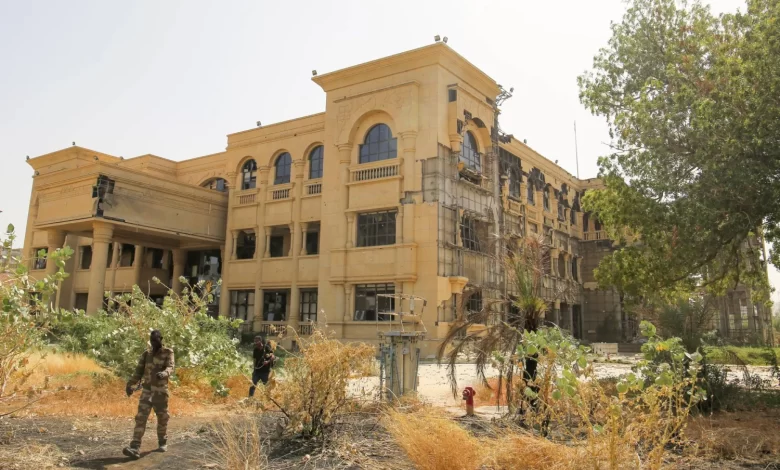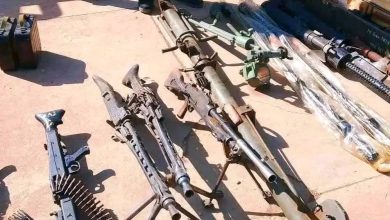Situation Report on Areas Recovered by the Army from the Militia

Report by: Abdul Raouf Taha
Severe infrastructure destruction and near-complete looting of property—that’s how the areas recently liberated by the Sudanese army from the grip of the Rapid Support Forces (RSF) in the Sudanese capital, Khartoum, appear after nearly two years of militia control.
Central Khartoum, which was recently reclaimed from RSF control, is one of the most vital areas in Sudan. It is bustling with markets, government institutions, and private sector businesses, including companies and organizations. It also houses Khartoum’s largest markets, hospitals, universities, schools, banks, hotels, and entertainment venues. However, the current state of the area stands in stark contrast to its former vibrancy.
Looting and Destruction
According to traders and employees who previously worked in Central Khartoum, the RSF looted and plundered all commercial establishments in the area, especially banks and markets. This includes the well-known gold markets in the heart of the Arab market, as well as more than 10 banks that were looted, burned, and completely destroyed.
Destruction of High-Rise Buildings
The destruction extended to several high-rise buildings owned by both the public and private sectors, such as the Nile Petroleum Tower, which was completely destroyed and burned. Other damaged structures include Coral Hotel, Al-Fatih Tower, Meridian Hotel, the Grand Hotel, Iwa Tower, and Belous Towers—all of which were landmarks of Khartoum.
According to a senior Sudanese army source who spoke to Al Jazeera Net, the Al-Mogran area, which contains several towers, was used by the RSF for sniper operations and heavy artillery attacks on the Engineering Corps west of Al-Mogran and the army defenses west of the Rescue Bridge. Some towers, such as Belous Tower, were used to shell the army’s headquarters.
Bank Looting
The banks in central Khartoum were not spared from the devastation and looting. Al Jazeera Net documented the damage inflicted on the Central Bank of Sudan, the Sahel and Sahara Bank, Faisal Islamic Bank, Omdurman National Bank, the Savings Bank, Nile Bank, and the Agricultural Bank.
In a press statement, the Sudanese army accused the RSF of looting the banks, particularly the Central Bank of Sudan, which contained reserves of gold and foreign currency. The army reported that the banks in central Khartoum were turned into piles of rubble after being looted and burned, and subsequently converted into military barracks by the RSF.
Hospitals in Crisis
Hospitals in central Khartoum faced similar devastation. A government source, speaking anonymously, said that some hospitals were stripped of their equipment, which was transported to the Darfur region in western Sudan. Hospital funds were looted, while other hospitals were turned into weapons depots.
Army officers told Al Jazeera Net that the Al-Zaytouna and Imperial hospitals, west of the army headquarters, were used by RSF snipers and artillery to target and kill army personnel.
Markets Set Ablaze
Within the first 72 hours of the war’s outbreak in April 2023, the RSF looted the entire contents of the markets in central Khartoum. While the area is not residential, it hosts Khartoum’s most important markets.
Footage documents the massive destruction in the area, with once-bustling markets now abandoned. The Arab Market, previously the busiest market, is now littered with unexploded shells, burnt-out tanks, destroyed military vehicles, and bodies lying on the ground.
Situation in Tuti Island
The situation on Tuti Island, located at the confluence of the Blue and White Nile, is equally grim. Tuti Island, one of Sudan’s oldest towns inhabited primarily by northern Sudanese tribes, suffered heavily during the war.
Civil society organizations documented the killing of dozens of Tuti residents and the forced evacuation of all island inhabitants. Over time, the RSF turned the island into a military base to shell Omdurman and support their forces in Bahri and Khartoum.
Recently, the army reclaimed Tuti Island as part of its military campaign in central Khartoum. However, the once-thriving island has become eerily quiet, with only the sound of birds breaking the silence.
Tuti’s displaced residents have scattered to different Sudanese cities, and destruction has become a defining feature of all areas reclaimed from the RSF. Looted markets and the absence of movement have left Tuti with nothing but the flow of the Nile as a silent witness to the violations.
Al-Mogran Neighborhood
In Al-Mogran, a resident told Al Jazeera Net that it was one of the first neighborhoods where civilians were forcibly displaced when the war between the army and RSF began.
He recounted how RSF forces arrived at residents’ homes early in the conflict and ordered them to evacuate immediately. “We later learned that the eviction was to secure a visit from Abdul Rahim Dagalo, the RSF deputy commander, who eventually arrived in Al-Mogran and addressed his troops.”
After the army reclaimed Al-Mogran, the neighborhood was left deserted. Most homes were abandoned, many doors were broken, and the area was subjected to widespread looting.
Source: Al Jazeera Net



